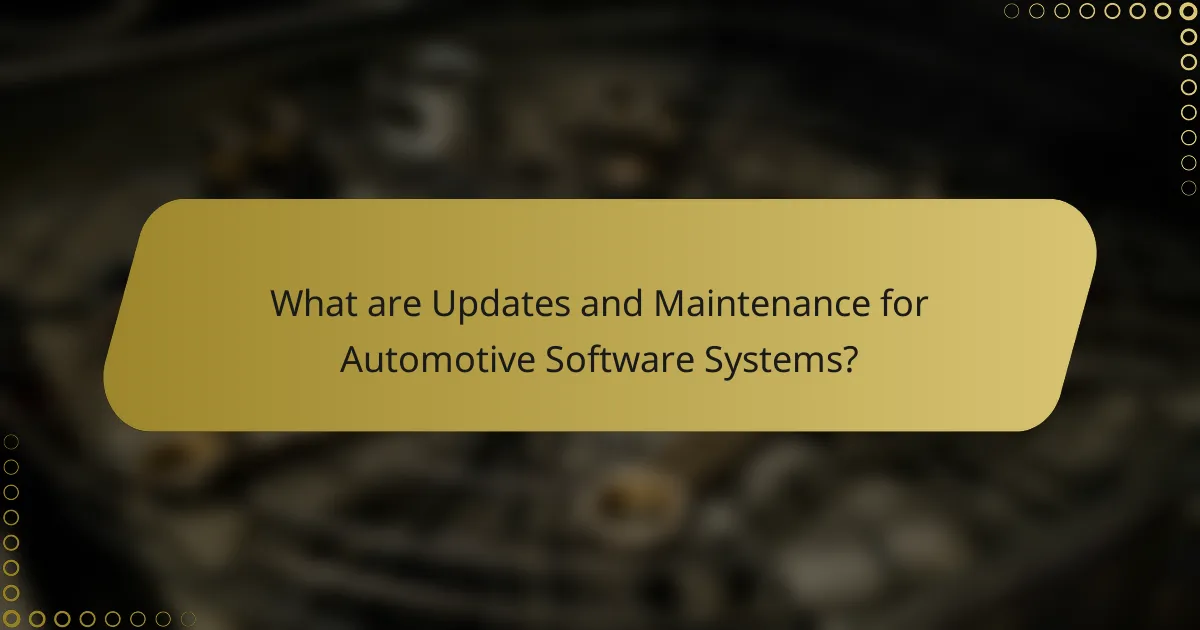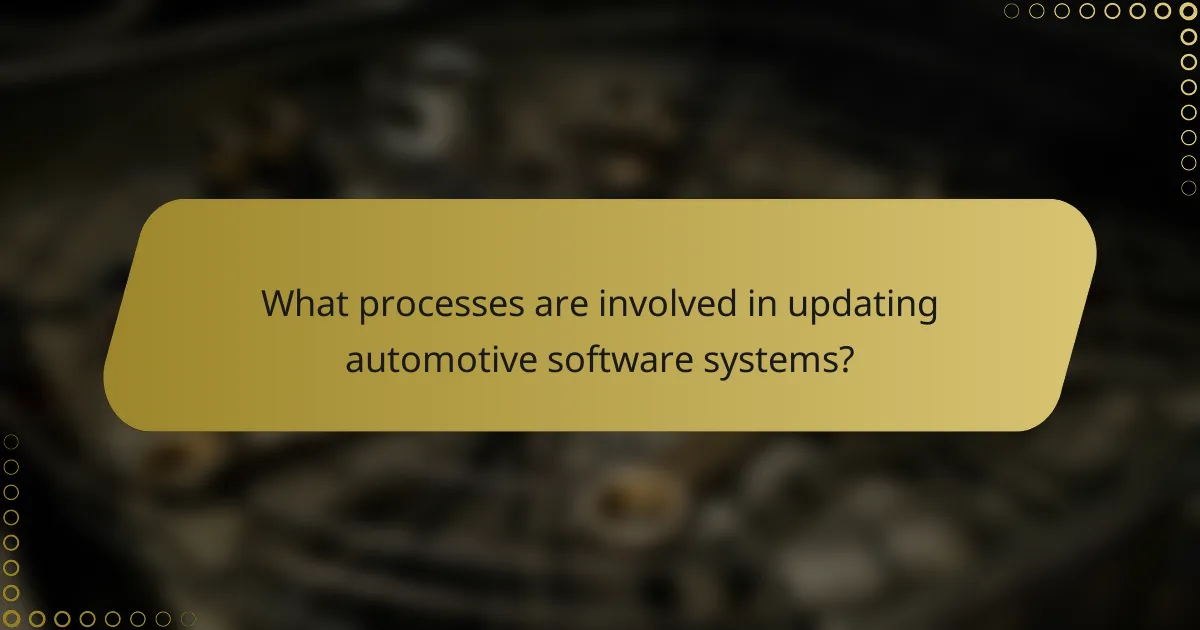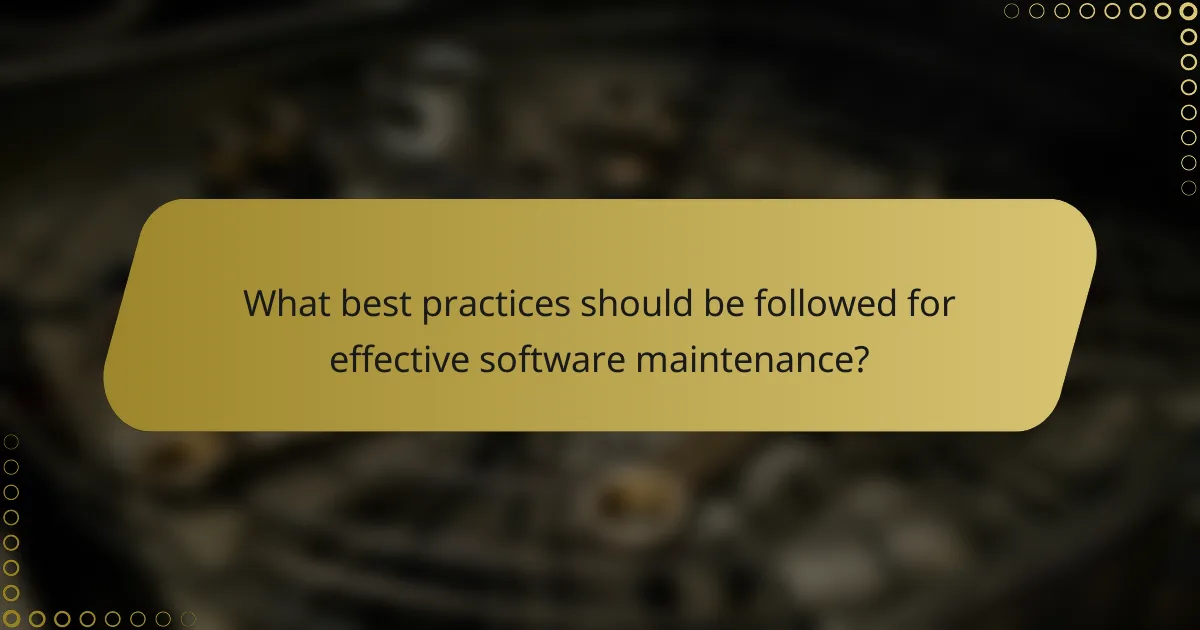Automotive software systems require regular updates and maintenance to ensure optimal performance and security. These processes include software assessment, downloading, installation, and post-update testing, which enhance vehicle safety and functionality. Effective maintenance practices involve thorough documentation, proactive monitoring, version control, and user feedback, all of which contribute to the longevity and reliability of the software. Regular updates not only improve performance but also reduce the risk of cyber threats, making them essential for modern vehicles.

What are Updates and Maintenance for Automotive Software Systems?
Updates and maintenance for automotive software systems involve the regular enhancement and support of software used in vehicles. These processes ensure that the software operates efficiently and securely. Updates may include new features, performance improvements, and security patches. Maintenance involves monitoring system performance and fixing any identified issues. Regular updates can enhance vehicle safety and functionality. According to a study by McKinsey, software updates can reduce the risk of cyber threats in automotive systems. Effective maintenance can prolong the lifespan of the software and improve user experience.
How do updates impact automotive software systems?
Updates enhance the functionality and security of automotive software systems. They can introduce new features that improve user experience and vehicle performance. Updates also fix bugs that may cause system malfunctions or vulnerabilities. For example, a 2021 study by McKinsey found that software updates can increase vehicle efficiency by up to 20%. Additionally, updates can improve safety by addressing vulnerabilities that could be exploited by cyber threats. Regular updates ensure compliance with evolving regulations in the automotive industry. This proactive maintenance approach helps maintain the vehicle’s value over time.
What types of updates are commonly applied to automotive software?
Automotive software commonly undergoes several types of updates. These include software patches, which address security vulnerabilities and bugs. Feature updates enhance existing functionalities or introduce new features. Calibration updates adjust vehicle settings for optimal performance and compliance with regulations. Map updates improve navigation systems with the latest road data. Firmware updates ensure that hardware components operate correctly with the latest software. Over-the-air updates allow manufacturers to deploy updates remotely, improving convenience for users. Each type of update plays a crucial role in maintaining vehicle performance and safety.
Why is regular maintenance crucial for automotive software systems?
Regular maintenance is crucial for automotive software systems to ensure optimal performance and safety. Automotive software controls critical functions such as engine management and safety systems. Neglecting maintenance can lead to software bugs and vulnerabilities. These issues may compromise vehicle safety and reliability. Regular updates fix bugs and improve system functionality. Maintenance also ensures compliance with evolving regulatory standards. According to a study by the National Highway Traffic Safety Administration, 94% of crashes are due to human error, which can be mitigated by reliable software. Therefore, maintaining automotive software is essential for enhancing vehicle safety and performance.
What challenges are associated with updates and maintenance?
Challenges associated with updates and maintenance in automotive software systems include compatibility issues, security vulnerabilities, and resource constraints. Compatibility issues arise when new software versions do not work well with existing hardware or software. This can lead to system malfunctions or reduced functionality. Security vulnerabilities may be introduced during updates, exposing vehicles to cyber threats. Resource constraints such as limited bandwidth or processing power can hinder the deployment of updates. Additionally, regulatory compliance can complicate the update process, requiring thorough testing and documentation. These challenges can impact the overall reliability and safety of automotive systems, necessitating careful planning and execution of updates and maintenance activities.
How do manufacturers address cybersecurity concerns during updates?
Manufacturers address cybersecurity concerns during updates by implementing robust security protocols. They conduct thorough vulnerability assessments before deploying updates. This includes analyzing potential threats and weaknesses in the software. Manufacturers often use encryption to protect data during the update process. They also employ secure boot mechanisms to ensure only verified software is loaded. Regular monitoring for anomalies post-update is standard practice. Additionally, manufacturers may provide user education on recognizing security risks. These measures are essential to safeguard against cyber threats in automotive software systems.
What are the potential risks of neglecting software maintenance?
Neglecting software maintenance can lead to significant risks. These risks include security vulnerabilities, as outdated software may not receive critical updates. Performance issues can arise from unoptimized code, leading to inefficiencies. Compatibility problems may occur with new hardware or software, resulting in system failures. Additionally, neglect can cause increased downtime due to unresolved bugs. Financial losses may be incurred from system failures and the costs associated with emergency repairs. According to a report by the National Institute of Standards and Technology, the cost of fixing a software defect increases exponentially the longer it remains unaddressed. Thus, regular maintenance is essential to mitigate these risks.

What processes are involved in updating automotive software systems?
Updating automotive software systems involves several key processes. First, software assessment is conducted to evaluate the current version and identify necessary updates. Next, a software download occurs, where the new version is obtained from a secure server. Following this, the installation process begins, which often includes the vehicle being connected to a diagnostic tool or a Wi-Fi network. During installation, the system verifies compatibility and integrity of the new software. After installation, a reboot of the system is typically required to apply changes. Finally, post-update testing is performed to ensure functionality and performance meet standards. These processes are crucial for maintaining vehicle safety and performance.
How is the update process initiated?
The update process is initiated through a software management system within the vehicle. This system checks for available updates from the manufacturer. The vehicle’s onboard diagnostics communicate with the manufacturer’s servers. Once an update is detected, the system prompts the user for permission to proceed. After receiving approval, the update is downloaded and installed. This process ensures that the vehicle software remains current and secure. Regular updates enhance vehicle performance and safety features.
What roles do diagnostics play in the update process?
Diagnostics play a crucial role in the update process of automotive software systems. They identify issues that may arise during updates. Diagnostics help in assessing the current state of the software. This assessment ensures compatibility with new updates. They also provide feedback on the success of the update. Diagnostics can highlight errors or failures in real-time. This feedback allows for timely corrections. Effective diagnostics improve the overall reliability of the software.
How are updates distributed to vehicles?
Updates are distributed to vehicles primarily through over-the-air (OTA) technology. This method allows manufacturers to send software updates directly to vehicles via wireless internet connections. OTA updates can include enhancements, bug fixes, and new features. Many modern vehicles are equipped with cellular or Wi-Fi connectivity to facilitate this process.
In addition to OTA updates, some manufacturers may also use USB drives or diagnostic tools at service centers for updates. These methods can be necessary for vehicles without internet connectivity. The use of OTA technology has grown significantly, with reports indicating that over 80% of new vehicles are capable of receiving OTA updates. This shift allows for more efficient and timely software management in automotive systems.
What tools are used for maintenance of automotive software?
Automotive software maintenance tools include integrated development environments (IDEs), version control systems, and diagnostic software. IDEs like Eclipse or Visual Studio are used for coding and debugging. Version control systems such as Git help manage changes in software code. Diagnostic tools, like Vector CANalyzer, are essential for testing and troubleshooting automotive systems. These tools ensure software updates are efficient and reliable. They also help maintain compliance with automotive standards like ISO 26262.
What software platforms facilitate updates and maintenance?
Software platforms that facilitate updates and maintenance include Over-the-Air (OTA) solutions, cloud-based platforms, and dedicated automotive software management systems. OTA solutions allow manufacturers to remotely update vehicle software without requiring physical access to the vehicle. Examples include Tesla’s software update system, which has been shown to enhance vehicle performance and add new features seamlessly. Cloud-based platforms like Microsoft Azure and AWS provide scalable infrastructure for managing software updates and data analytics. Dedicated automotive software management systems, such as Vector’s vFlash, support the complete lifecycle of software updates, including testing and deployment. These platforms ensure that vehicles remain up-to-date with the latest features and security patches, thereby enhancing overall vehicle performance and safety.
How do diagnostic tools assist in maintaining automotive software systems?
Diagnostic tools assist in maintaining automotive software systems by identifying and troubleshooting issues efficiently. They provide real-time data on the performance of software components. This allows technicians to pinpoint faults quickly. Diagnostic tools can also facilitate software updates by ensuring compatibility with existing systems. They often include features for monitoring system health over time. This proactive approach helps prevent potential failures. Furthermore, these tools generate reports that aid in compliance with industry regulations. Their use contributes to overall vehicle reliability and safety.

What best practices should be followed for effective software maintenance?
Effective software maintenance requires regular updates, thorough documentation, and proactive monitoring. Regular updates ensure that software remains secure and functional. Documentation provides clarity on software changes and facilitates easier troubleshooting. Proactive monitoring allows teams to identify and resolve issues before they escalate. Additionally, employing version control helps manage changes systematically. Conducting regular code reviews enhances code quality and maintainability. User feedback is crucial for identifying areas for improvement. Finally, implementing automated testing can streamline the maintenance process and reduce errors. These practices collectively contribute to the longevity and reliability of software systems.
How can vehicle owners ensure their software is up to date?
Vehicle owners can ensure their software is up to date by regularly checking for updates through their vehicle’s infotainment system or manufacturer’s website. Many manufacturers provide software updates to enhance performance and security. Owners should also subscribe to notifications from their vehicle manufacturer for the latest updates. Additionally, connecting the vehicle to Wi-Fi can facilitate automatic updates. Some vehicles may require a visit to a dealership for software updates. Regular maintenance checks can also include software inspections. This practice helps maintain optimal vehicle functionality and safety.
What steps should be taken to verify software updates?
To verify software updates, first, check the source of the update. Ensure it comes from a reputable vendor or official website. Next, review the update notes or changelog for details on changes and improvements. After that, perform a backup of the current system before applying the update. Once the update is applied, test the software for functionality and performance. Monitor the system for any unexpected behavior post-update. Finally, consult user forums or support channels for feedback on the update’s reliability. These steps help ensure the update is safe and effective.
What are common troubleshooting tips for automotive software issues?
Common troubleshooting tips for automotive software issues include checking for software updates. Ensure the vehicle’s software is up to date. Outdated software can cause performance issues. Restarting the vehicle’s system can also resolve minor glitches. Disconnecting and reconnecting the battery may reset the system. Inspecting the vehicle’s diagnostic trouble codes (DTCs) can identify specific problems. Utilizing an OBD-II scanner can help retrieve these codes. Finally, consulting the vehicle’s manual can provide specific troubleshooting steps for software-related issues.
How can users identify software-related problems in their vehicles?
Users can identify software-related problems in their vehicles by monitoring warning lights on the dashboard. These lights often indicate issues with the vehicle’s software systems. Users should also pay attention to unusual behavior in vehicle functions. This includes erratic performance of features like navigation or entertainment systems. Regularly checking for software updates is crucial. Manufacturers often release updates to fix bugs or improve performance. Users can access diagnostic tools or apps to run software checks. These tools can provide error codes related to software malfunctions. Consulting the vehicle’s manual can also offer guidance on troubleshooting software issues.
What resources are available for resolving automotive software issues?
Resources for resolving automotive software issues include manufacturer technical support, online forums, and diagnostic tools. Manufacturer technical support provides expert assistance for specific vehicle models. Online forums host discussions where users share solutions and experiences. Diagnostic tools, such as OBD-II scanners, help identify software-related faults. Additionally, software updates from manufacturers can fix bugs and improve functionality. Access to service manuals offers detailed troubleshooting steps. Industry publications provide insights into common software issues and solutions. These resources collectively enhance the ability to address automotive software problems effectively.
Updates and maintenance for automotive software systems are essential processes that ensure the efficient and secure operation of vehicle software. This article outlines the importance of regular updates, which enhance functionality, performance, and security, while also addressing the various types of updates and the critical role of maintenance in prolonging software lifespan and improving user experience. It highlights the challenges associated with updates, such as compatibility issues and cybersecurity concerns, and discusses best practices for effective software management. Additionally, the article provides insights into the tools and processes involved in updating automotive software, as well as troubleshooting tips for users to identify and resolve software-related problems.
